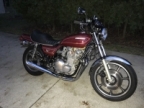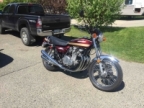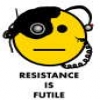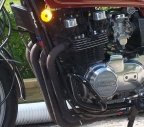Flooding left side carb
- Qsmothers3
-
 Topic Author
Topic Author
- Offline
- User
-

Registered
- Posts: 78
- Thanks: 1
Flooding left side carb
21 Nov 2021 11:30
So I have a 1982 kz440 and the left side carb pours out gas when there is a full tank of fuel on the bike. When the tank is about half full the carb stops flooding. I have put the float level on both carbs within spec according to the manual. I've never had a problem with the right side carb but I cannot seem to get the left side to stop flooding....any advice?
Please Log in or Create an account to join the conversation.
- Mikaw
-

- Offline
- Sustaining Member
-

Registered
- Posts: 4836
- Thanks: 1851
Re: Flooding left side carb
21 Nov 2021 11:48
Just a guess but it might be a worn float needle. The added weight and pressure of a full tank might be enough to push fuel past a worn needle or seat. Have you checked both seats, are they the same size.
1976 KZ 900 A4
kzrider.com/forum/11-projects/613548-1976-kz-900-a4
1976 KZ 900 B1 LTD
1978 KZ 1000 B2 LTD
1980 KZ 750 E1
Kowledge Speaks, But Wisdom Listens.
Jimi Hendrix.
1976 KZ 900 B1 LTD
1978 KZ 1000 B2 LTD
1980 KZ 750 E1
Kowledge Speaks, But Wisdom Listens.
Jimi Hendrix.
Please Log in or Create an account to join the conversation.
- Qsmothers3
-
 Topic Author
Topic Author
- Offline
- User
-

Registered
- Posts: 78
- Thanks: 1
Re: Flooding left side carb
21 Nov 2021 12:10
When I had the carb apart I replaced the float needle. I sure hope its not the seat, I'd have to replace the whole carb if thats the case I believe.
Please Log in or Create an account to join the conversation.
- Qsmothers3
-
 Topic Author
Topic Author
- Offline
- User
-

Registered
- Posts: 78
- Thanks: 1
Re: Flooding left side carb
21 Nov 2021 12:19
Is there a way to test fuel levels on a bench? Perhaps without buying the special tool the manual suggests?
Please Log in or Create an account to join the conversation.
- hardrockminer
-

- Offline
- Sustaining Member
-

Registered
- Posts: 3108
- Thanks: 1214
Re: Flooding left side carb
21 Nov 2021 12:37Is there a way to test fuel levels on a bench? Perhaps without buying the special tool the manual suggests?
Yes. Read this thread.
www.kzrider.com/forum/forum-index/3-carb...n-setting-fuel-level
I have several restored bikes along with a 2006 Goldwing with a sidecar.
Please Log in or Create an account to join the conversation.
- Mikaw
-

- Offline
- Sustaining Member
-

Registered
- Posts: 4836
- Thanks: 1851
Re: Flooding left side carb
21 Nov 2021 12:47
You can take your carb bowl to your local hardware or auto store and test fit clear hose into the drain screw. I’ve never tried but others say with the correct size you can twist (thread) the clear hose into the bowl. Then set the carbs in a quick homemade stand. Level and plumb them and test the float levels.
1976 KZ 900 A4
kzrider.com/forum/11-projects/613548-1976-kz-900-a4
1976 KZ 900 B1 LTD
1978 KZ 1000 B2 LTD
1980 KZ 750 E1
Kowledge Speaks, But Wisdom Listens.
Jimi Hendrix.
1976 KZ 900 B1 LTD
1978 KZ 1000 B2 LTD
1980 KZ 750 E1
Kowledge Speaks, But Wisdom Listens.
Jimi Hendrix.
Please Log in or Create an account to join the conversation.
- TexasKZ
-

- Offline
- Platinum Member
-

Registered
- Posts: 8075
- Thanks: 2595
Re: Flooding left side carb
21 Nov 2021 13:33 - 21 Nov 2021 13:34
There is likely also a problem with the petcock (fuel valve). If it was shutting off properly, there would be only the fuel in the line available for flooding.
1982 KZ1000 LTD parts donor
1981 KZ1000 LTD awaiting resurrection
2000 ZRX1100 not ridden enough
www.kzrider.com/11-projects/620336-anoth...uild-thread?start=24
1981 KZ1000 LTD awaiting resurrection
2000 ZRX1100 not ridden enough
www.kzrider.com/11-projects/620336-anoth...uild-thread?start=24
Last edit: 21 Nov 2021 13:34 by TexasKZ.
Please Log in or Create an account to join the conversation.
- Qsmothers3
-
 Topic Author
Topic Author
- Offline
- User
-

Registered
- Posts: 78
- Thanks: 1
Re: Flooding left side carb
21 Nov 2021 13:48
See thats a weird thing with this bike too. There is no off position on the petcock. Only reserve, on and prime.
Please Log in or Create an account to join the conversation.
- TexasKZ
-

- Offline
- Platinum Member
-

Registered
- Posts: 8075
- Thanks: 2595
Re: Flooding left side carb
21 Nov 2021 13:53
Yes, that is correct. There should be a vacuum hose attached to one carb and to the valve. When the engine starts, the vacuum opens the valve and lets fuel flow. When the engine is shut off, the vacuum disappears and the valve shuts off. After a few years, the rubber bits inside the valve deteriorate and need to be replaced. It is always a good idea to carefully polish the seat that the sealing oring presses against, as well as the face (sealing surface) of the control lever.
1982 KZ1000 LTD parts donor
1981 KZ1000 LTD awaiting resurrection
2000 ZRX1100 not ridden enough
www.kzrider.com/11-projects/620336-anoth...uild-thread?start=24
1981 KZ1000 LTD awaiting resurrection
2000 ZRX1100 not ridden enough
www.kzrider.com/11-projects/620336-anoth...uild-thread?start=24
Please Log in or Create an account to join the conversation.
- F64
-

- Offline
- User
-

Registered
- 81-KZ440D2
- Posts: 1140
- Thanks: 412
Re: Flooding left side carb
21 Nov 2021 14:07 - 21 Nov 2021 14:22
Did you use an OEM Kawasaki float needle?
from Mike Nixon at motorcycleproject
motorcycleproject.com/text/float_valves.html
"As a carburetor rebuild customer there is one thing you need to understand above all else. A thing you have probably never thought about, a thing that has probably never even been on your radar, and yet it is the single most important aspect of your carburetor rebuild. It's more important than the method of cleaning, more important than shipping methods, and believe it or not, even more critical than the experience and reputation of the rebuilder you choose. Float valves. Ninety percent of carburetor rebuilders, including some pretty well known ones, ignore the simple but scandalous fact that the huge glut of available aftermarket float valves from all kinds of sources are absolute crap and will turn even the most skillfully and carefully performed carb rebuild into a disaster. They're simply not well made. And with a carburetor's float system already by design being a tenuous quest for liquid tightness, aftermarket float valves just turn a peaceful but delicate detante into a full-fledged war, guarantying that the customer will have to be constantly vigilent and learn to make allowances and excuses for chronically incontinent carburetors.
Float valves
When I began doing carburetors full-time I tried using aftermarket float valves. They were incredibly bad. I began vacuum-testing brand-new ones right out of the package before installing them. The result was I had to throw more than half of them away. They wouldn't seal. I had to buy ten to get four, at best. And even the ones that sealed initially quit sealing after a short while. Or the valves would fit poorly, too small in diameter or too long, both causing issues. I tested both OEM and aftermarket every day on every rebuild for over a year. I don't test OEM float valves any more. One hundred percent pass the vacuum test. Every single one. Now, the first thing a carburetor customer looks for is fuel-tightness. I'm going to use crap float valve and send him carbs I know are going to leak? Hardly. I can't understand why anyone would use these parts, especially people who rebuild carburetors for a living. And don't forget, these bad float valves are often found in rebuild kits. Between this and the abysmally bad Chinese needle jets and jet needles, carb kits are no bargain. In fact they're death to your carburetors. I won't guarantee carbs that contain them.
Now you know why I rebuild only Honda carburetors. They are the only Big Four brand factory float valves can be got for now. Later Kawasakis used the same brand of carbs as Honda so I do late model Kawasaki carburetors frequently also. But if I can't get factory float valves for a carb set I won't rebuild the carbs. I won't make excuses. That means I don't do older Kawasakis, Yamahas and Suzukis. There are no OEM float valves left for these.
And now, finally, and tragically, even the Honda float valves are drying up. I won't start using crap float valves and making excuses to my customers. What a terrible thing to have to do. Here's the thing, though. Why aren't the rebuilders who use K&L, Keyster, Napco and other float valves making such excuses? Why aren't their customers being warned that the carbs will overflow? It's perplexing to me. Maybe most customers fail to maintain their carbs from one season to the next, and thus they never realize the poor quality parts that are in there, chalking up eventual leaking issues to "it's time to rebuild them again." And it's even more likely most rebuilders just don't care. Too awfull bad, that is."
from Mike Nixon at motorcycleproject
motorcycleproject.com/text/float_valves.html
"As a carburetor rebuild customer there is one thing you need to understand above all else. A thing you have probably never thought about, a thing that has probably never even been on your radar, and yet it is the single most important aspect of your carburetor rebuild. It's more important than the method of cleaning, more important than shipping methods, and believe it or not, even more critical than the experience and reputation of the rebuilder you choose. Float valves. Ninety percent of carburetor rebuilders, including some pretty well known ones, ignore the simple but scandalous fact that the huge glut of available aftermarket float valves from all kinds of sources are absolute crap and will turn even the most skillfully and carefully performed carb rebuild into a disaster. They're simply not well made. And with a carburetor's float system already by design being a tenuous quest for liquid tightness, aftermarket float valves just turn a peaceful but delicate detante into a full-fledged war, guarantying that the customer will have to be constantly vigilent and learn to make allowances and excuses for chronically incontinent carburetors.
Float valves
When I began doing carburetors full-time I tried using aftermarket float valves. They were incredibly bad. I began vacuum-testing brand-new ones right out of the package before installing them. The result was I had to throw more than half of them away. They wouldn't seal. I had to buy ten to get four, at best. And even the ones that sealed initially quit sealing after a short while. Or the valves would fit poorly, too small in diameter or too long, both causing issues. I tested both OEM and aftermarket every day on every rebuild for over a year. I don't test OEM float valves any more. One hundred percent pass the vacuum test. Every single one. Now, the first thing a carburetor customer looks for is fuel-tightness. I'm going to use crap float valve and send him carbs I know are going to leak? Hardly. I can't understand why anyone would use these parts, especially people who rebuild carburetors for a living. And don't forget, these bad float valves are often found in rebuild kits. Between this and the abysmally bad Chinese needle jets and jet needles, carb kits are no bargain. In fact they're death to your carburetors. I won't guarantee carbs that contain them.
Now you know why I rebuild only Honda carburetors. They are the only Big Four brand factory float valves can be got for now. Later Kawasakis used the same brand of carbs as Honda so I do late model Kawasaki carburetors frequently also. But if I can't get factory float valves for a carb set I won't rebuild the carbs. I won't make excuses. That means I don't do older Kawasakis, Yamahas and Suzukis. There are no OEM float valves left for these.
And now, finally, and tragically, even the Honda float valves are drying up. I won't start using crap float valves and making excuses to my customers. What a terrible thing to have to do. Here's the thing, though. Why aren't the rebuilders who use K&L, Keyster, Napco and other float valves making such excuses? Why aren't their customers being warned that the carbs will overflow? It's perplexing to me. Maybe most customers fail to maintain their carbs from one season to the next, and thus they never realize the poor quality parts that are in there, chalking up eventual leaking issues to "it's time to rebuild them again." And it's even more likely most rebuilders just don't care. Too awfull bad, that is."
81-KZ440-D2.
Louis Dudzik's GM HEI ignitor conversion installed 2015 s3.amazonaws.com/gpzweb/Ignition/GPZgmHEImod.html
Motogadget m-unit blue installed 2017.
LIC, NY
Louis Dudzik's GM HEI ignitor conversion installed 2015 s3.amazonaws.com/gpzweb/Ignition/GPZgmHEImod.html
Motogadget m-unit blue installed 2017.
LIC, NY
Last edit: 21 Nov 2021 14:22 by F64.
Please Log in or Create an account to join the conversation.
- JR
-

- Offline
- Sustaining Member
-

Registered
- Posts: 2961
- Thanks: 477
Re: Flooding left side carb
21 Nov 2021 14:43
Everyting posted above.
Plus
With some carbs eg Keihnin CV34 (I think the 400 & 440s have Keihins) the seats are pressed in and are not replaceable. So, next time you open the carbs run a Q tip dipped in Brasso around the seat and rinse with carb cleaner.
Plus
With some carbs eg Keihnin CV34 (I think the 400 & 440s have Keihins) the seats are pressed in and are not replaceable. So, next time you open the carbs run a Q tip dipped in Brasso around the seat and rinse with carb cleaner.
1980 kz750E1, Delkevic exhaust
The following user(s) said Thank You: taildragger1197, Mikaw, Qsmothers3
Please Log in or Create an account to join the conversation.
- Qsmothers3
-
 Topic Author
Topic Author
- Offline
- User
-

Registered
- Posts: 78
- Thanks: 1
Re: Flooding left side carb
21 Nov 2021 14:45
So there should be no fuel coming out of the tank when it is off the bike if the petcock is working properly......I definitely have an issue there cuz even with the tank off the bike and the petcock set to res it has a slow drip..
Please Log in or Create an account to join the conversation.
Moderators: Street Fighter LTD
